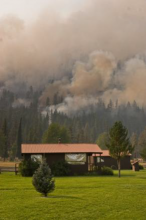Introduction
The National Risk Analysis Report is the third report of the National Cohesive Wildland Fire Management Strategy (Cohesive Strategy). This Phase III report, in conjunction with the National Action Plan to be released in early 2014, represents the culmination of more than three years of effort in developing an innovative national approach to address the increasingly complex reality of wildland fire management in the United States. The intent of this report is to develop a comprehensive, science-based cohesive strategy that addresses the significant, long-standing challenges to managing the ever-growing wildfire situation facing this nation.
These major challenges include:
- Threats to Healthy Landscapes: Declining forest and rangeland health associated with the exclusion of periodic fires with decades of aggressive wildfire suppression and lack of active management of wildland fuels across the national landscape, have significantly contributed to a decline in fire-resilient ecosystems, an increase in wildfire burn severity, and the increasing risk of destructive wildfires that damage landscapes and threaten associated communities. This threat is further exacerbated by climatic changes, insect and disease outbreaks, and the expansion of invasive species.
- Threat of Wildfire to Communities: Prevention and suppression of all wildfires is not always possible. Many citizens, especially those living in or near fire-prone communities, generally have not recognized or accepted the need to assume primary responsibility for making their individual properties fire-resistant.
- Risk to Public and Firefighter Safety: Public and firefighter safety must always take precedence over property and resource loss. Increasing trends in the size of large wildfires, their intensity, and the growth and complexity of the wildland-urban interface and intermix continue to present obstacles to protecting life and property.



In late 2012, the National Science and Analysis Team (NSAT) was asked to explore potential options for achieving the national goals of the Cohesive Strategy and to identify the challenges, opportunities, and trade-offs inherent in each option. The purpose of this national analysis is to provide a broad strategic overview that could inform subsequent decision-making processes. For example, options explored here can help inform choices among more detailed activities described within regional action plans or suggest where actions could be focused from a national program management perspective. This section briefly summarizes the findings of the NSAT in relation to potential policy options that could be considered for national implementation. Here, “policy options” are broadly defined as strategic national direction that would lead to achieving the goals of the Cohesive Strategy. The policy options support intergovernmental decisions regarding whether we should maintain, emphasize, or de-emphasize the various mixes of management actions in different contexts and locations.
The key to building national policy options is to understand the underlying relationships among biophysical landscapes, the people that inhabit them, and wildland fire. Gaining a national perspective also requires an approach that essentially dissolves or ignores regional boundaries in order to more clearly see national patterns of similarities and differences.